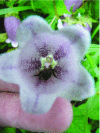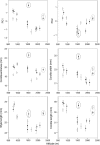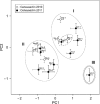Changes in pollinator fauna affect altitudinal variation of floral size in a bumblebee-pollinated herb
- PMID: 25535556
- PMCID: PMC4228614
- DOI: 10.1002/ece3.1191
Changes in pollinator fauna affect altitudinal variation of floral size in a bumblebee-pollinated herb
Abstract
Geographic trait variations are often caused by locally different selection regimes. As a steep environmental cline along altitude strongly influences adaptive traits, mountain ecosystems are ideal for exploring adaptive differentiation over short distances. We investigated altitudinal floral size variation of Campanula punctata var. hondoensis in 12 populations in three mountain regions of central Japan to test whether the altitudinal floral size variation was correlated with the size of the local bumblebee pollinator and to assess whether floral size was selected for by pollinator size. We found apparent geographic variations in pollinator assemblages along altitude, which consequently produced a geographic change in pollinator size. Similarly, we found altitudinal changes in floral size, which proved to be correlated with the local pollinator size, but not with altitude itself. Furthermore, pollen removal from flower styles onto bees (plant's male fitness) was strongly influenced by the size match between flower style length and pollinator mouthpart length. These results strongly suggest that C. punctata floral size is under pollinator-mediated selection and that a geographic mosaic of locally adapted C. punctata exists at fine spatial scale.
Keywords: Geographic selection mosaic; local adaptation; mechanical fit; phenotypic selection; pollination efficiency.
Figures







Similar articles
-
Altitudinal flower size variation correlates with local pollinator size in a bumblebee-pollinated herb, Prunella vulgaris L. (Lamiaceae).J Evol Biol. 2015 Oct;28(10):1761-9. doi: 10.1111/jeb.12693. Epub 2015 Jul 27. J Evol Biol. 2015. PMID: 26174480
-
An altitudinal cline in UV floral pattern corresponds with a behavioral change of a generalist pollinator assemblage.Ecology. 2015 Dec;96(12):3343-53. doi: 10.1890/15-0242.1. Ecology. 2015. PMID: 26909439
-
Intraspecific convergence of floral size correlates with pollinator size on different mountains: a case study of a bumblebee-pollinated Lamium (Lamiaceae) flowers in Japan.BMC Ecol Evol. 2021 Apr 24;21(1):64. doi: 10.1186/s12862-021-01796-8. BMC Ecol Evol. 2021. PMID: 33894742 Free PMC article.
-
Intraspecific variation in morphology of spiny pollen grains along an altitudinal gradient in an insect-pollinated shrub.Plant Biol (Stuttg). 2023 Mar;25(2):287-295. doi: 10.1111/plb.13493. Epub 2022 Dec 10. Plant Biol (Stuttg). 2023. PMID: 36440587
-
Selection by pollinators on floral traits in generalized Trollius ranunculoides (Ranunculaceae) along altitudinal gradients.PLoS One. 2015 Feb 18;10(2):e0118299. doi: 10.1371/journal.pone.0118299. eCollection 2015. PLoS One. 2015. PMID: 25692295 Free PMC article.
Cited by
-
Phenotypic variation of floral organs in flowering crabapples and its taxonomic significance.BMC Plant Biol. 2021 Oct 30;21(1):503. doi: 10.1186/s12870-021-03227-8. BMC Plant Biol. 2021. PMID: 34717537 Free PMC article.
-
Human-Mediated Land Use Change Drives Intraspecific Plant Trait Variation.Front Plant Sci. 2021 Jan 14;11:592881. doi: 10.3389/fpls.2020.592881. eCollection 2020. Front Plant Sci. 2021. PMID: 33519849 Free PMC article.
-
An elevational gradient in floral traits and pollinator assemblages in the Neotropical species Costus guanaiensis var. tarmicus in Peru.Ecol Evol. 2023 Jul 28;13(8):e10314. doi: 10.1002/ece3.10314. eCollection 2023 Aug. Ecol Evol. 2023. PMID: 37529588 Free PMC article.
-
Floral resource availability declines and florivory increases along an elevation gradient in a highly biodiverse community.Ann Bot. 2025 Feb 8;135(1-2):199-210. doi: 10.1093/aob/mcae155. Ann Bot. 2025. PMID: 39223914 Free PMC article.
-
Intraspecific independent evolution of floral spur length in response to local flower visitor size in Japanese Aquilegia in different mountain regions.Ecol Evol. 2022 Mar 1;12(3):e8668. doi: 10.1002/ece3.8668. eCollection 2022 Feb. Ecol Evol. 2022. PMID: 35261751 Free PMC article.
References
-
- Alexander J, Edwards P, Poll M, Parks C. Dietz H. Establishment of parallel altitudinal clines in traits of native and introduced forbs. Ecology. 2009;90:612–622. - PubMed
-
- Anderson B. Johnson SD. The geographical mosaic of coevolution in a plant-pollinator mutualism. Evolution. 2007;62:220–225. - PubMed
-
- Anderson B. Johnson SD. Geographic covariation and local convergence of flower depth in a guild of fly-pollinated plants. New Phytol. 2009;182:533–540. - PubMed
-
- Bell G. On the function of flowers. Proc. R. Soc. Lond. B Biol. Sci. 1985;224:223–265.
LinkOut - more resources
Full Text Sources
Other Literature Sources
Research Materials

